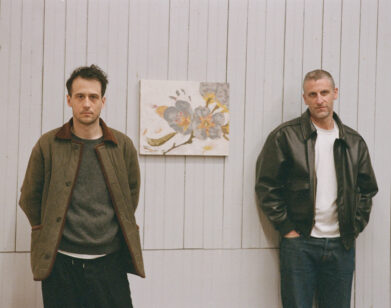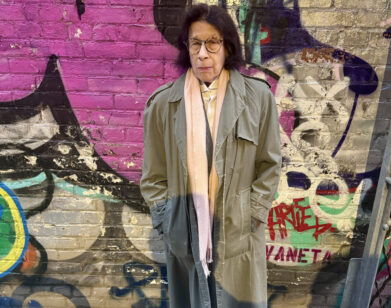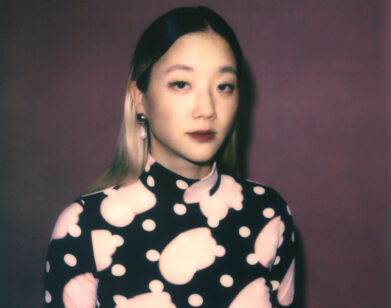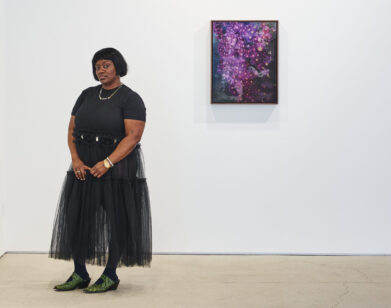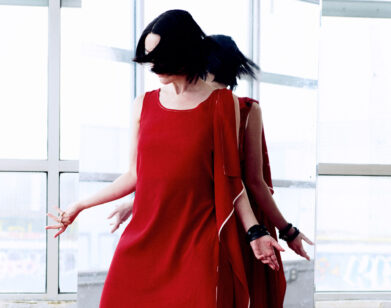Discovery: Egan Frantz
Egan Frantz describes his latest work for “Room Temperature,” his solo show at Roberts & Tilton, Los Angeles, which opens Nov. 3: a system of seven buckets, each with their own fish tank aeration system and filled with empty champagne bottles. “The show that these buckets will be appearing in,” says Frantz, laughing into the phone from his Brooklyn studio, “I didn’t go out planning this, but all the materials—bubbles, baguettes, buckets, bottles, and the list goes on—everything begins with a B.”
Alliteration aside, Frantz is a student of Freud and Heidegger, but he’s quick to say that’s just the skin of the onion. Peel away the philosophical layer, and you have an artist devoted to crafting complex and finely tuned systems of absurdly rational communication. For instance, baguettes tell a story, and buckets speak the language of the “bubble.”
AGE: 26
HOMETOWN: Norwalk, Connecticut
CURRENT CITY: Brooklyn
SOMETHING FROM NOTHING: Novelty and advent ex nihilo are important subjects for art, and I’m working through them. The figure of the craftsman is a very interesting figure, because he supposedly works with pre-existing material, so it’s not conducive to drawing out of the void (“ex nihilo“), yet I think he’s in a “structural drama,” is what I call it. For me, what’s playing out that drama are the various characters. So the buckets, in that sense, are the speakers. They’re literally speaking in an onomatopoetic sense: they’re speaking “bubble.” When you hear a bubble, it’s saying “bubble.”
THE SPACE BETWEEN WORDS AND OBJECTS: It’s a spectrum issue, or an issue of intensity. On the one hand, I identify as Freudian, so I reject the belief that reality can be captured in language. But I’m also interested in object-oriented philosophy: Heidegger’s doctrine of the broken tool. There are people who work with this much more explicitly, the so-called “speculative realists,” for instance. Quentin Meillassoux coined the term “correlationist,” which refers to all philosophy after Kant—including Kant—which basically says, everything is in relation to thinking. My feeling is: if you look at a chair, you don’t exhaust a chair any more than if you sit in a chair. I had a work that dealt with that pretty explicitly, but that’s since changed—I’m working on it now to improve that work—but what was carved into the work was, “Neither fish nor fowl, nor fish and fowl at once.” This is an impossible thing to imagine, but that’s the point. What we have to reason with is that what we call the impossible is not impossible. The impossible happens every day. No probabilistic theory can deal with that. But this isn’t what I do. These are my interests. I read like anybody else. Ultimately, I’m making artworks in the field of fine arts.
A WISE MAN ONCE SAID: I went to a school called Hampshire College, which you design your own curriculum. I could take a sculpture course (which I didn’t) or a critical theory course (which I did) or a poetry course (which I didn’t, but I was working very closely with a poet). I don’t have a classical education in poetry. There are huge gaps in my knowledge. The same, of course, goes for classical literature and philosophy, but I do love wisdom. The work is perhaps a demonstration of certain truths that I believe in. What I hope to demonstrate with the work is that theory and practice are essentially on the same level. The chair isn’t exhausted by looking at it; it’s also not exhausted by sitting in it. It’s got something of its own without us altogether, yet we’re also looking at it and sitting in it. That’s why I feel what’s important are intensities. Society rarely recognizes intensities, if you look at critical debates, there are no real intensities; it’s just ideological structures.
BREAKING BAD BREAD: Take the work that I’ve done with the baguettes. I like baguettes. I have them in the kitchen. Sometimes they go stale, often before you finish them—often before I’ve even touched them. A good baguette goes stale by the evening if you buy it in the morning. The choice is that you can throw it out, or you can make French toast or some variation on that theme, or I developed a new one, which is to make these works. So what I do is make a mold of the stale bread—I pour silicon on the top—I pull the bread out of it, and I grind it up, either in a Cuisinart or by pulverizing it with a mallet in a bag. I’ve done it numerous ways; it doesn’t make a difference. Bring it to a “ground bread,” and then what I do is I mix that bread with an epoxy resin, and I pour that back into the mold, so we have that entire baguette there in the baguette. It’s a closed process. Sometimes closing down is more important than this idea of openness of process in the studio. Sometimes the object has an intensity in and of itself that cannot be exhausted no matter what we do to it, so we’ve got to let the object lead. I make a baguette out of a baguette. I let the baguette lead. I’m also manipulating it with my hands, so we’re engaged in a contract together.
LESS THAN ZERO: Because the bottle happens to be just the perfect length for the standard five-gallon bucket, subtle evaporation changes the intensity of the bubble, because the lip of the bottle is so close to the surface. It’s important to tune them. Get the volume and speed right. As the water evaporates, the sound changes. So there is no constancy, even though the appearance might be similar to Rob Pruitt’s “Eternal Bic,” it’s not “Eternal Bic.”
The champagnes that are in there, they’re not overly expensive, because the fact is, great champagne is really not that cost-prohibitive. Cristal is not the best champagne. Dom Pérignon is by far not the best champagne. These are major labels that are selling a brand, and their flavor is fake. They’re dosed with sugar; every country has a different version with more sweetness and less sweetness. The ones that you get in England are dryer than the ones you get here. They source their grapes from wherever in order to produce a signature flavor year after year. So people, when they buy Veuve Clicquot, they get “Veuve Clicquot.”
Normally, what I drink is the grower’s champagne, because they’re wonderful. They’re all different; they’re made with one grape, from one vineyard. Generally, it’s one family that’s been doing it for a long time. They’re just so much more complex to taste. They don’t have the additives, the sugar dosage. They’re simply better. The ones that put in the work are the ones that I really like. I tend to prefer the chardonnay blanc de blancs.
There’s something about an effusive arrogance that comes from the explosion, this celebratory overabundance when a guy wins the race and sprays the champagne all over everyone. I don’t believe in excess. I would never pop a champagne bottle like that. I might be searching for audacity, but these works are titled with the “less than” sign of inequality before the make of the champagne that was once consumed. So, they have the bubbles, but not the champagne bubble. They have the bubble that I love, but they don’t have the arrogance. It’s a kind of tuning.


